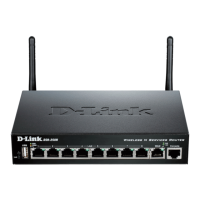Unified Services Router User Manual
30
2.5 Captive Portal
LAN users can gain internet access via web portal authentication with the DSR. Also referred to as
Run-Time Authentication, a Captive Portal is ideal for a web café scenario where users initiate
HTTP connection requests for web access but are not interested in accessing any LAN services.
Firewall policies underneath will define which users require authentication for HTTP access, and
when a matching user request is made the DSR will intercept the request and prompt for a username
/ password. The login credentials are compared against the Runtime Authentication users in user
database prior to granting HTTP access.
DSR-150/150N/250/250N does not have support for the Captive Portal feature.
Captive Portal is available for LAN users only and not for DMZ hosts.
Setup > Captive Portal >Captive Portal Sessions
The active run time internet sessions through the router’s firewall are listed in the below table.
These users are present in the local or external user database and have had their login credentials
approved for internet access. A ‘Disconnect’ button allows the DSR admin to selectively drop an
authenticated user. The “Block MAC” button will result in the selected client being added to the
blocked list, and the current and future sessions from this client will be prevented.
Figure 14: Active Runtime sessions
2.5.1 Captive Portal Setup
Setup > Captive Portal >Captive Portal Setup
Captive Portal is a security mechanism to selectively provide authentication on certain interfaces.
This page displays configured custom Captive Portal profiles and indicates which are in use.

